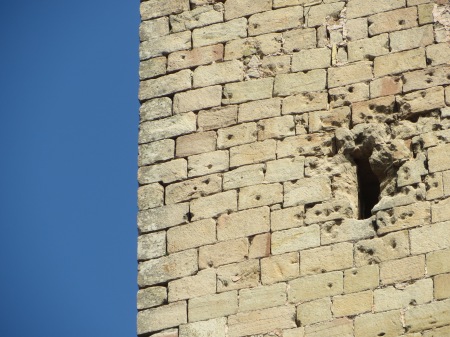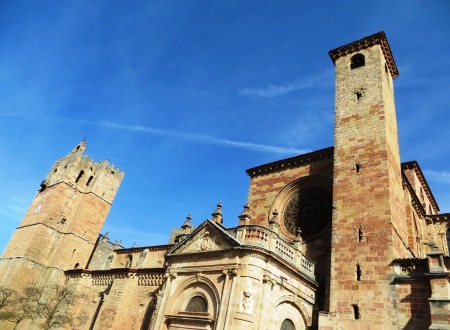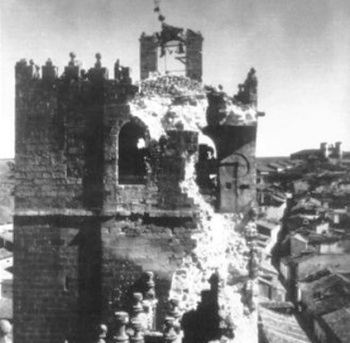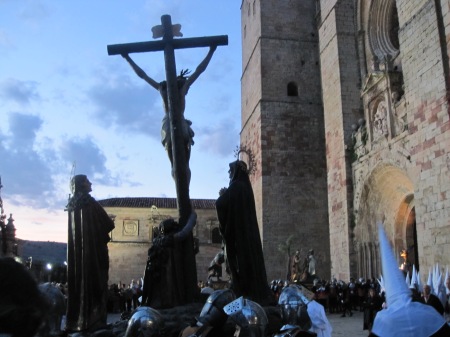“Does the bloodshed of 1936 mean that the traveller can no longer relax at a café table in Sigüenza? If so he cannot relax anywhere in Spain.” – Christopher Howse – ‘A Pilgrim in Spain’
After a long day in the car no one said a great deal but I am fairly certain everyone was pleased to be back in Sigüenza. It was late afternoon and the sun was still shining so we did the obvious thing and walked to the bar on the Plaza Mayor and ordered some beers.
As the memory of the pointless journey began to slip into instant obscurity and as we sat and chatted amongst ourselves I looked around the Plaza and paid more attention to the details. The colonnaded façade of the Town Hall, the weathered stone symbols over the doors – the heraldic emblems of previous owners, the street signs, the metal railings and the stonework of the tall cathedral as it began to cast its shadow as the sun shifted position in the sky.
We were sitting close to the South Tower which reaches into the blue and has small-fortress like windows at regular intervals and the description fortress-like is rather appropriate because they bear the marks of shell damage inflicted on the building in 1936 during the Spanish Civil War. The Battle of Sigüenza took place from 7th August 1936 to 15th October 1936 and although it seemed difficult to imagine this peaceful and languid afternoon there was heavy fighting here then.
Sigüenza occupied an important strategic geographical position in a narrow valley on the main road and railway line between Madrid and Aragon and Catalonia. This is not a surprise, the Romans, the Moors and the Catholic Monarchs of the Reconquista had all previously fortified this place.
Early in the conflict the town had fallen under the control of the Nationalist insurgents but was liberated by Republican loyalists in late July and the town came under the control of the left-wing extremist ‘Workers’ Party of Marxist Unification’ or POUM (a Trotskyisk organisation allied to the Left Opposition in Moscow against Stalin) and the Anarchist elements of the Republican army who were a dangerous and incendiary mix of discontented and revolutionary trade-unionists, communists and anti-clerics.
Sigüenza now became a victim of the ‘Red Terror’ which was a period of Republican atrocities during the Civil War including the killing of tens of thousands of people including many members of the Catholic clergy and the desecration, burning and looting of monasteries and churches. After taking control of the town Republican forces turned their anger against the religious hierarchy and structures, they celebrated their success with a blasphemous procession through the streets and then set fire to the Cathedral of Santa Maria.
During the Civil War twelve Bishops were killed, the first was the seventy year old cleric in Sigüenza, murdered by firing squad along with the Dean and the Chancellor of the Diocese, their bodies burned and hastily buried a couple of kilometres outside the town and left to be discovered by advancing Nationalist troops. A further sixty or so people quickly suffered a similar fate.
In September the Nationalist army was ready to attack as regulars and crack Foreign Legion troops manoeuvred into position, an air bombardment further damaged the cathedral and the town was completely surrounded.
Reinforcements turned back because of bad weather and failed to arrive and the situation quickly became critical for the defending troops. Losses were high and eventually the three hundred surviving militiamen and four hundred civilians took refuge and fortified themselves in the Cathedral (I wonder at this point if they regretted burning it down?) They held out for a week as Franco’s superior forces overran the town but eventually were obliged to surrender, some of the militia tried to make a run for it but they were all gunned down trying to escape.
The Nationalists took control of the town but the Cathedral was almost completely destroyed by a combination of the vandalism of the Republican defenders and the ferocious bombardment of the Nationalist besiegers. It was rebuilt, repaired and restored in the 1940s.
All of this was of course in complete contrast to the serene atmosphere of the late afternoon as families sat together in conversation, young lovers walked hand in hand and visitors stopped every so often to point a camera and eventually the sun began to dip and we finished our second drink and then left and made our way back to the hotel because we hadn’t left ourselves long to change and get ready to come back out again to watch the Semana Santa parade which I previously posted about here.






That first photo looks grim with all of the bullet holes. Ugh.
LikeLike
I wouldn’t have wanted to be inside!
LikeLike
War is horrible and cruel and inhumane. History keeps repeating war. When will it end?
Thank you for the tour and pictures capturing the Battle of Sigüenza, Andrew.
LikeLike
My father fought with the International Brigades….he didn’t talk about it…or anything else ….until he was very old, but still as sharp as ever.
There are, indeed, physical atrocities…and there are the years of misery, cruelty and injustice that give rise to them.
LikeLike
Have you read ‘Homage to Catalonia’ by Orwell?
LikeLike
Yes. Father knew him…and didn’t think much of him.
LikeLike
Did he give a reason? It is easy to form an opinion about someone through their writing that is probably not very accurate!
LikeLike
No..his opinion was formed on meeting the man….more than once.
I think father’s distaste is best expressed by Orwell’s description of his own distaste when a group of working men were passing round a bottle of beer and he realised his own lips would have to touch that bottle where their lips had been before him.
An interpreter of working class life without a knowledge of the basic language.
LikeLike
I realised from your previous comment that he must have met him. I meant it is easy to form an incorrect opinion just from the writing.
LikeLike
Sorry…put it down to post prandial doziness!
Yes, I agree about the impression of a person gained from their writings…I suppose we tend to read in the light of our own experience and prejudice.
LikeLike
I am fascinated by the information that your father met Orwell. I always suspected that he was a snob who denied his personal heritage. What other stories did he tell?
I like to read books by travellers and I enjoy reading them at ‘face value’ and then researching and discovering the conflicting truth behind them.
LikeLike
Hardly any until he was very old…and then a narratrive of the parts of his life important to him….born in 1900, died 1993.
In relation the the Spanish Civil War it was the enmity of the Communists for the Anarchists – and their undermining of the war effort of the Republic to that end that turned him against Communism.
LikeLike
Headed this way next week! Cool pic(:
LikeLike
I hope you enjoy the area!
LikeLike
A rather bigoted description of the siege and the POUM.
The sort of thing you find in Spanish school history books written under the dictatorship, not really accepted as accurate in the 21st century.
LikeLike
I apologise if I offend your Nationalist sympathies!
Maybe you could add a constructive alternative interpretation instead of just being rude!
LikeLike